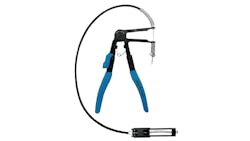Tool Review: Matco Tools Ratcheting Hose Clamp Pliers
Matco Tools' Ratcheting Hose Clamp Pliers are ideal for removing plastic and/or metal self-tensioning hose clamps, adjusting from 11/16" to 3-1/8". Matco's dual jaw head features one side for small and standard size hose clamps and another side for larger clamps. The ratcheting design allows the pliers to lock in place with the component, freeing up the user's hands during repairs. The pliers include a heavy duty braided cable, a clip position adjuster, and a 360-degree swivel cable assembly.
This tool was reviewed by Randy Kaiser, manager at RostMotor Inc. in Manson, Iowa.
Q: How did the tool function as far as saving you time?
A: The Ratcheting Hose Clamp Pliers do a great job of grabbing and holding on to those pesky spring hose clamps that manufacturers seem to be very fond of using. Without this tool, those clamps can be very tough and time-consuming to grab, compress, and release, and just as time-consuming to reinstall. This tool cuts that time down considerably.
Q: How easy was it to use?
A: The hose clamp pliers are very easy to use. You select which side of the clamping head will best fit your hose clamp (there are two different grip ranges), slide it over the clamp, and squeeze the handles together. It has a locking ratchet mechanism to hold the clamp open, and a quick-release lever to release the tension on the clamp to reinstall it.
Q: Was there a manual included?
A: There was no manual with the pliers, just some information printed on the cardboard piece that it was attached to. It’s very self-explanatory, and no manual is needed.
Q: What features did you like?
A: The pliers have two different size clamping jaws so that they can accommodate clamps from 11/16” through 3-1/8”. The grip handles have a nice, rubberized coating, making them easy to grip and very comfortable to use. There is also a quick-release handle to make it very easy to release the tension on the clamp.
Read more: Tool Review: Ingersoll Rand W3111 IQV20 1/4” Compact Impact Driver
Q: What features didn’t you like?
A: So far, I haven’t found anything that I haven’t liked.
Q: What types of jobs/repairs did you use this tool for?
A: I used the pliers to release spring hose clamps on heater hoses and radiator hoses during radiator replacements, water pump replacements, and various other operations involving the cooling system.
Q: Have you used a previous version of this tool?
A: I have, but they weren’t nearly as nice. The handles weren’t padded at all, and the latch release didn’t work nearly as well.
Q: Is there anything you had questions or concerns about regarding the tool?
A: No, the pliers are well designed, well made, and do the job that they're designed to do.
Q: On a scale of 1 to 10, how would you rate this tool overall? Why?
A: Probably a nine. The pliers are very nice and work very well, but it’s hard to be a perfect 10.
Fleet Maintenance affiliate PTEN contributed this review.
This product was given to the reviewer free of charge by the manufacturer.
